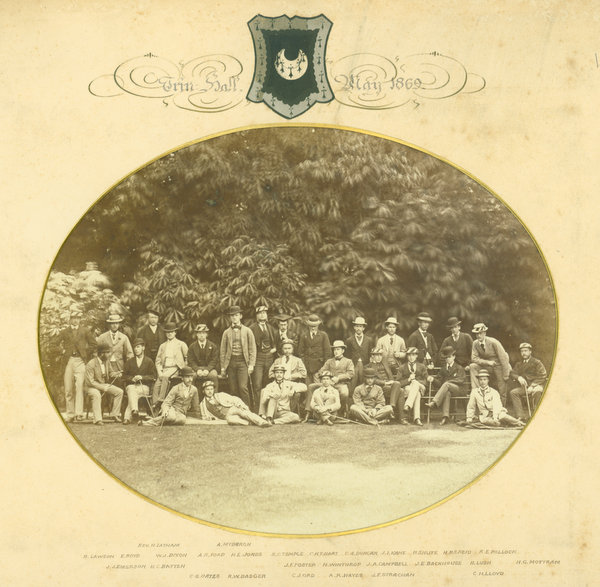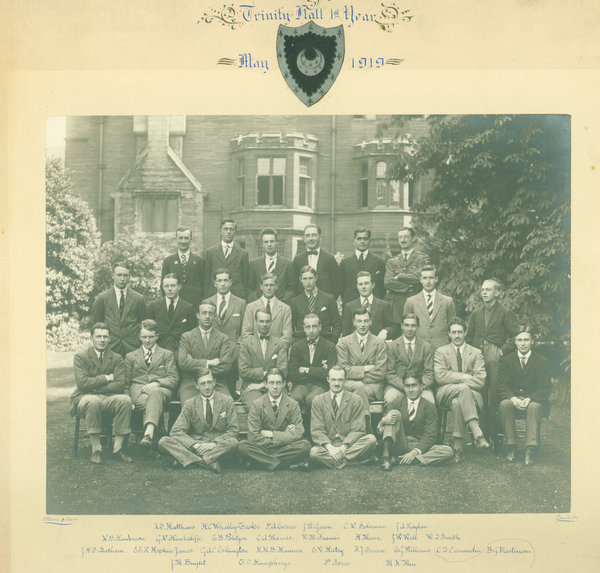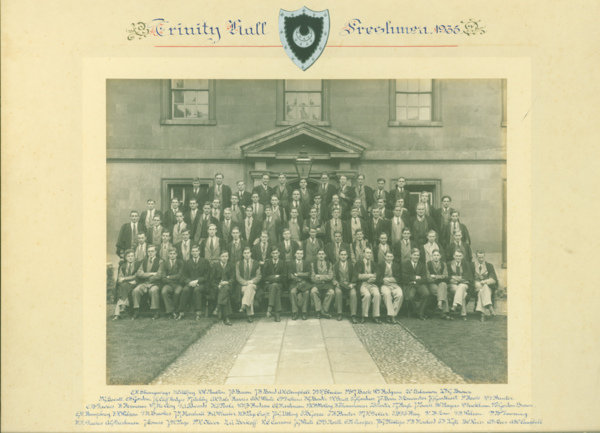This is a guest post by Lucy Holland
If one were to visit the home of any Cambridge student or alumni, it is almost certain that hung proudly on a wall is their matriculation photograph. The tradition of taking a photograph to mark the day of matriculation dates back to late 1800s, when photography was emerging as a more accessible and popular medium. Since then, every college has adopted the practice as a way of recording their new intake of students.
At Trinity Hall the archive houses a complete collection of undergraduate matriculation photographs for every year since 1869. This summer I have been undertaking a digitisation project to index the entire collection. My focus has been on inputting the names of all students present in each photograph into the central University archive database Janus. This will make it possible for researchers, alumni or their relatives to more easily locate individuals in the photographs. Along the way the project has resulted in some unexpected surprises, as well as provided a chance to reflect on the changes Trinity Hall has undergone over the last 150 years.
What is Matriculation?
Matriculation, derived from the Latin word ‘matricula’ meaning ‘register’, is the process which marks the formal admission of a student into the University body.[1] Our earliest record of the process at Cambridge University survives from 1544 in the form of matriculation registers compiled by the university central clerk. It was only from 1724 that students had to sign their own name in the register.[2] Fundamentally the process remains unchanged, with incoming students to this day signing a declaration form. However, now part of the tradition is for students to have a large group photograph with their peers.
A Timeless Tradition
Like any Cambridge tradition, there are many aspects of matriculation photography that has remained the same. The very earliest matriculation photograph, dated to 1869, is believed to be one of the first taken of a Cambridge undergraduate cohort.

The matriculation photograph from 1869 is the oldest in Trinity Hall’s archive, and likely one of the earliest taken in Cambridge. Note the inclusion of future master Henry Latham third from the left, one of the few photos taken of him.
It features a small group of men dressed with their best hats and canes – noticeably without gowns – casually arranged on chairs on Latham Lawn. Despite its age, it remains as recognisable as a matriculation photograph as those taken presently. The reasons for this are two-fold.
Firstly, the decoration and design of the paperboard mount used to display matriculation photographs remains almost entirely unchanged. The mount which houses the photograph for the 1869 admission of undergraduates features hand painted crests for Trinity Hall and university at the top, together with the college’s name, the year and the type of cohort handwritten in calligraphy. Below the photograph is a list of names of individuals as appear in the photograph, again handwritten. While today the mounts are printed, the style is exactly replicated down to the style of calligraphy and placement of the crests.
Secondly, with these photographs taken within college grounds the setting is always a recognisable corner of the college. There is no portion of Trinity Hall which has not over the years served as the backdrop for a matriculation photograph. Front Court, Latham Lawn, the Master’s Lodge, the Gatehouse Building, the Old Library, and the Latham building in particular have all featured at some point. It is uncertain who made the decision of where to locate the photograph, but it is a testament to the timeless beauty of Trinity Hall that so many of its buildings have set the scene for these commemorative photographs.
Reflections of Change
Cataloguing this wide range of photographs has also brought to light many of the changes that Trinity Hall has undergone throughout the past 150 years.
Most noticeably, these photographs can reveal trends in undergraduate numbers. The average number of students admitted in the 1860s was 50, rising to 67 by the 1890s. This was supplemented under Henry Latham’s mastership (1888-1902) by an increase in the number of students from overseas, including students from New Zealand, Australia Japan, and India.[3] Undergraduate numbers remained more or less the same until the war years of 1914-1918, when the college became almost entirely empty of students. In the immediate years that followed, when over 250 ex-servicemen and new undergraduates arrived at Trinity Hall, changes to college life were acutely felt and can be traced through the matriculation photographs. In the 1919 matriculation photograph a group of students can be seen wearing their military dress, including famous alumni and novelist and playwright J.B Priestley.

Taken in the Fellow’s Garden in May 1919, this photograph shows all the first year men who had arrived to Trinity Hall the previous October.

This photograph features all the men who returned to Trinity Hall following the end of World War I. Novelist and playwright J.B. Priestley is amongst this cohort.
Between 1920-39 cohort sizes increased as Trinity Hall underwent expansion of student numbers to an average of 87 students. The majority of these students were to read arts subjects such as Law and English, though there was a slight increase in the uptake of Natural Sciences.[4] It also became mandatory from the late 1920s for gowns to be worn in the matriculation photograph, and have remained a familiar fixture to this day.

The 1935 matriculation photograph is one of the first where undergraduates are wearing gowns, a tradition which continues to this day.
From the 1950s, student numbers continued to increase, averaging around one hundred students. A trend also emerged at this time for students to hold an identifying card with their number on it, ensuring that they could be easily identified on the list of names. The system was later changed in the 1980s to arranging students alphabetically.
The 1970s is perhaps the most significant decade of change for the matriculation photograph. It became tradition during this time for the Master, and later the Senior Tutor, to participate by sitting front and centre amongst the students. But perhaps most monumental is the 1977 photograph which is the first to feature women, this being the year when the first cohort of female undergraduates were admitted to Trinity Hall.
It is being able to chart changes such as these, that has made this digitisation project so rewarding and also incredibly valuable. Each of the college’s matriculation photographs is a vibrant and unique historical artefact that has much to tell us about life at Trinity Hall.
[1] K. Taylor, Central Cambridge: A Guide to the University and Colleges (Cambridge University Press, 2008), p. 106.
[2] H.E. Peek and C.P Hall, Archives of The University of Cambridge (Cambridge University Press, 2009), pp.30-31.
[3] C. Crawley, Trinity Hall: The History of a Cambridge College, 1350-1975 (Cambridge University Press, 1976), p. 180.
[4] C. Crawley, Trinity Hall: The History of a Cambridge College, 1350-1975 (Cambridge University Press, 1976), p. 211.